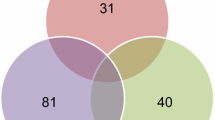Abstract
This study aimed to diagnose renal allograft dysfunction with specific biomarkers by serum proteomic analysis. Surface-enhanced laser desorption/ionization time-of-flight mass spectrometry (SELDI-TOF MS) and bioinformatics (support vector machine and leave-one cross validation) were used to analyze serum proteome. Enrolled patients included 38 biopsy-proved acute rejection (BPAR), 10 acute tubular necrosis (ATN), 24 subclinical rejection (SCR) and 29 stable control recipients verified by protocol biopsy. A characteristic protein profile can be detected in each renal allograft dysfunction group. BPAR patients were differentiated from stable patients with markers of 9710.1, 4971, 6675.5, 8563.8, 6709.2, 9319 and 4476.7 Da with high sensitivity and specificity. ATN can be clearly distinguished from BPAR and stable control. Subclinical rejection differentiated from stable control with markers of 9193.1, 2759.1, 8464.6 Da. The independent blind test yielded with high specificity and sensitivity for each group. Serum proteome analysis by SELDI-TOF MS combined with bioinformatics in renal allograft dysfunction is valuable and promising. Specific markers were detected in each group. Identification of these proteins may prove useful as diagnostic markers for allograft dysfunction and better to elucidate the mechanism of acute rejection.



Similar content being viewed by others
References
Nankivell BJ, Chapman JR (2006) Chronic allograft nephropathy: current concepts and future directions. Transplantation 815:643–654
Cornell LD, Colvin RB (2005) Chronic allograft nephropathy. Curr Opin Nephrol Hypertens 143:229–234
Schwarz A et al (2005) Risk factors for chronic allograft nephropathy after renal transplantation: a protocol biopsy study. Kidney Int 671:341–348
Colvin RB (2003) Chronic allograft nephropathy. N Engl J Med 34924:2288–2290
Choi BS et al (2005) Clinical significance of an early protocol biopsy in living-donor renal transplantation: ten-year experience at a single center. Am J Transplant 56:1354–1360
Shishido S et al (2003) The impact of repeated subclinical acute rejection on the progression of chronic allograft nephropathy. J Am Soc Nephrol 144:1046–1052
Strom TB (2005) Rejection–more than the eye can see. N Engl J Med 35322:2394–2396
Jianghua C et al (2005) C4d as a significant predictor for humoral rejection in renal allografts. Clin Transplant 196:785–791
Chen JH, Wang RD, wu JY (2004) The impact of early vascular rejection on late rejection in 1062 cadaveric renal transplant. J Am Soc Nephrol 15:812
Wu JY et al (2004) Improved clinical outcomes in Chinese renal allograft recipients receiving lower dose immunosuppressants. Transplantation 785:713–718
Muthukumar T et al (2005) Messenger RNA for FOXP3 in the urine of renal-allograft recipients. N Engl J Med 35322:2342–2351
Wittke S et al (2005) Detection of acute tubulointerstitial rejection by proteomic analysis of urinary samples in renal transplant recipients. Am J Transplant 510:2479–2488
Flechner SM et al (2004) Kidney transplant rejection and tissue injury by gene profiling of biopsies and peripheral blood lymphocytes. Am J Transplant 49:1475–1489
Sarwal M et al (2003) Molecular heterogeneity in acute renal allograft rejection identified by DNA microarray profiling. N Engl J Med 3492:125–138
Rai AJ et al (2005) Analysis of human proteome organization plasma proteome project (HUPO PPP) reference specimens using surface enhanced laser desorption/ionization-time of flight (SELDI-TOF) mass spectrometry: multi-institution correlation of spectra and identification of biomarkers. Proteomics 513:3467–3474
Tolson J et al (2004) Serum protein profiling by SELDI mass spectrometry: detection of multiple variants of serum amyloid alpha in renal cancer patients. Lab Invest 847:845–856
Issaq HJ et al (2003) SELDI-TOF MS for diagnostic proteomics. Anal Chem 757:148A–155A
Fung E et al (2003) The use of SELDI ProteinChip array technology in renal disease research. Methods Mol Med 86:295–312
Xu WH et al (2006) Preoperatively molecular staging with CM10 ProteinChip and SELDI-TOF-MS for colorectal cancer patients. J Zhejiang Univ Sci B 73:235–240
Yu JK et al (2005) An integrated approach utilizing proteomics and bioinformatics to detect ovarian cancer. J Zhejiang Univ Sci B 64:227–231
Chen YD et al (2004) Artificial neural networks analysis of surface-enhanced laser desorption/ionization mass spectra of serum protein pattern distinguishes colorectal cancer from healthy population. Clin Cancer Res 1024:8380–8385
Mao Y et al (2008) Diagnosis of renal allograft subclinical rejection by urine protein fingerprint analysis. Transpl Immunol 183:255–259
Schaub S et al (2004) Proteomic-based detection of urine proteins associated with acute renal allograft rejection. J Am Soc Nephrol 151:219–227
O’Riordan E et al (2004) Bioinformatic analysis of the urine proteome of acute allograft rejection. J Am Soc Nephrol 1512:3240–3248
Racusen LC, Halloran PF, Solez K (2004) Banff 2003 meeting report: new diagnostic insights and standards. Am J Transplant 410:1562–1566
O’Riordan E, Goligorsky MS (2005) Emerging studies of the urinary proteome: the end of the beginning? Curr Opin Nephrol Hypertens 146:579–585
Clarke W et al (2003) Characterization of renal allograft rejection by urinary proteomic analysis. Ann Surg 2375:660–664 discussion 664–665
Somorjai RL, Dolenko B, Baumgartner R (2003) Class prediction and discovery using gene microarray and proteomics mass spectroscopy data: curses, caveats, cautions. Bioinformatics 1912:1484–1491
Byvatov E, Schneider G (2003) Support vector machine applications in bioinformatics. Appl Bioinformatics 22:67–77
Furey TS et al (2000) Support vector machine classification and validation of cancer tissue samples using microarray expression data. Bioinformatics 1610:906–914
Wang JX et al (2006) Application of serum protein fingerprint in diagnosis of papillary thyroid carcinoma. Proteomics 619:5344–5349
Nankivell BJ et al (2003) The natural history of chronic allograft nephropathy. N Engl J Med 34924:2326–2333
Acknowledgments
This research was supported by the National High Technology Research and Development Program of China (863 Program, 2006AA02A248), Key Projects in the National Science & Technology Pillar Program in the Eleventh Five-year Plan Period (2008BAI60B04), Major projects of Zhejiang Science and Technology Department(2008C13026-2).
Author information
Authors and Affiliations
Corresponding author
Rights and permissions
About this article
Cite this article
Wang, M., Jin, Q., Tu, H. et al. Detection of renal allograft dysfunction with characteristic protein fingerprint by serum proteomic analysis. Int Urol Nephrol 43, 1009–1017 (2011). https://doi.org/10.1007/s11255-011-9962-5
Received:
Accepted:
Published:
Issue Date:
DOI: https://doi.org/10.1007/s11255-011-9962-5




